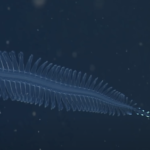
So how did going organic affect your pocketbook? I imagine for many of you it didn’t add as much as you thought it would. This weeks will be a little easier and that is why I will ask you to continue it through the year.
The request:Go to the Seafood Watch and download a chart for your wallet or purse. Carry it everywhere you go from now on. Adhere to it and harass others to to the same.
The reason:Again, I could lay out a well-reasoned argument for why you should do this, but you know all the reasons. The good news is that I’ve moaned about all this before, again, and again, and again, and again, and again, and again, and again, and again, and again, and again.
Ongoing challenges:
1a.
1b. Keep reading DSN and participating in the Just One Thing Challenge
2. Use no plastic grocery and shopping bags for the next week. Use, and purchase if necessary, reusable bags. Recycle all plastic bags around the house at a participating location.
3. Start pestering the hell out of Trader Joes.
4. When you buy your groceries, if the option presents itself, buy organic. The goal here is to be conscious about your buying decisions buy organic, opt for less packaged goods, and buy locally when you can.
People accepting the Just One Thing Challenge: 1. Craig McClain 2. Kevin Zelnio 3. Peter Etnoyer 4. Sheril K. 5. Mike G 6. Farne 7. Jim Lemire 8. Kiki 9. Fish Guy Dave 10. CK 11. Karen James 12. Merisea 13. Keely 14. tonyj 15. Traci 16. Mrs. Hillary Victoria Minor 17. Peter Mc 18. Tony D 19. Mary Aloyse Firestone 20. Miriam Goldstein 21.John 22. Judith in Ottawa 23. tjewell 24. Slim 25. Ashley 26. Silver 27. Steve W. 28. John Hill 29. Rachel 30. tjewell 31. Eric 32. jebyrnes 33. Lynna Landstreet 34. Ole 35. Carrie 36. Max 37. You?






I love DSN, I’ll elbow past most everything else to read a new post from DSN. But I have to disagree with part of your approach to changing the world. I respect you immensely for tackling this, of course.
I don’t think it’s a good idea to harass people with your Seafood Watch info, and it’s also not a good idea to pester Trader Joe’s.
These people are our allies in changing fishing, they’re NOT AN ENEMY that needs harassing or pestering. I won’t go on and on with this, I’ll just refernce my most recent post on this subject: saving the ocean with guilt or desire
Mark,
I appreciate your view point but I respectfully disagree. Seafood Watch is a powerful guide to making choices on which seafood to not eat and eat . It allows people to choose seafood alternatives that can be sustainable and healthy and thereby providing a financial incentive for appropriate methods. I hope by doing this we actually support the seafood industry. No one here is claiming they are the enemy.
With regard to Trader Joe’s, I again never indicated they are the enemy. However, a deep-sea fishery cannot be sustainable given the physiology and life history of these species. Informing Trader Joe’s and asking for change is not pestering. Again we are trying to work with them. Note I did advocate boycotting TJ’s.
If you feel this is not the route you want to take then please feel free not to continue on.
While I have some small quibbles with the Guide* as written, I too have to respectfully disagree with Mark. We should be encouraging the average consumer to think about what seafood they choose to buy and how it was harvested. Doing so doesn’t antagonize the fishermen, but rather promotes those who have developed more sustainable forms of harvesting. One possible example might be the U.S. longline fishery for swordfish, which has now been taken off the “bad” list based on its use of circle hooks and best-practice release protocols for bycatch species, even while imported swordfish remains recommended against. If the consumers ask, then the buyers will have to know, and the knowledge moves up and down the chain. It’s indeed a start, at least!
* Like swordfish, yellowfin and albacore in the U.S. Atlantic fishery are caught commercially by pelagic longline. If the swordfish product gets rewarded for the same fishery, and both tuna species remain at sustainable biomass levels, then why the discrepancy? Add the same “domestic longline” caveat to those two species too.
In regards to last week’s challenge, we already get our produce from the farmer’s market. (though the sustainability of lettuce grown in the high desert is a whole ‘nother issue.)
In regards to Mark’s comment, I think that pestering a corporation is not the same as pestering your friends. I don’t see anything wrong with writing to Trader Joe’s – as a loyal customer, I want them to live up to their reputation for sustainability. But pestering your friends about seafood, I think, should be approached cautiously – I know that after talking with ardent veggies or vegans that I have the urge to kill a cow with my bare hands and gnaw on a still-bleeding steak. I fear that too vigorous a plug for Seafoood Watch will have a similar effect.
That said, I already carry the Seafood Watch card around in my wallet and have passed it out to my friends and family.
psst…close your italics tag…
I work with large seafood buyers, and I’ve talked to them about buying decisions, sustainability criteria, etc. Pressuring/encouraging Trader Joe’s to drop certain species, by itself, does not save fish.
We need smart, effective, integrated campaigns to save fish, and selective buying can matter when it’s done in the context of an integrated campaign.
Lacking a campaign, Trader Joe’s might drop orange roughy, but someone else will buy what Trader Joe’s didn’t buy, and we’ll all feel good about doing nothing.
And it’s not good enough to say, well we changed one corner of the world. Changing the behavior of Trader Joe’s is not the goal. Think it through, what’s the real goal? And how will you try to forge a linkage between Trader Joe’s behavior and the real goal?
OK, this is too close to a shameless plug, but it will help explain my view on sustainable seafood. If you’re interested, swing by http://www.oceanconservancy.org/seafood
And here’s an article of interest on saving troubled fisheries, from the seafood industry press reporting on a panel discussion at this year’s Seafood Summit. The panel was about how to get real in saving a red-listed fish. It doesn’t work for well-heeled buyers to just walk away, so long as others still want to buy the fish.
Again I disagree with Mark, removing Orange Roughy from Trader Joe’s will save fish. People are misinformed or uninformed about what fish are ok to consume. A store like Trader Joe’s compounds this because many shoppers have the mind set that TJ’s is ecologically forward thinking. Friends of mine who consistently shop at TJ’s assumed that the fish there was sustainable given TJ’s persona. One of the only places in my area that sells Roughy is Tj’s and I don’t believe anyone is going to seek out another source. Simply put people buy Orange Roughy because it is there.
You make the comment that “someone else will buy what Trader Joe’s didn’t buy, and we’ll all feel good about doing nothing.” But that makes the assumption that in someway Orange Roughy will be sold somewhere else. With the current potential of Orange Roughy to make the IUCN and already being listed on many country lists I don’t think there is much of a market for extra Orange Roughy. Less demand for the fish will mean there is less financial incentive for its harvest.
You also seem to to question the Just One Thing Challenge. I applaud the efforts of your organization and others. I strongly believe that we need to work with industry to conserve the oceans as opposed to setting up false dichotomies. But the goal of this challenge is what an individual can do, what power we have, how we can make difference. Our greatest power lies in our voice, our purchases, and our votes. At the beginning of this challenge I will concentrate on our purchases and daily choices. However, it is also important to exercise our voice.
I didn’t get far on the organic challenge. I shop at Winco for financial reasons and their organic offerings are limited to milk, a rack of organic herbs and maybe a few items in the produce section.
But I’ve been carrying around a Seafood Watch card for probably 6-7 years, and it has been a great help in making good seafood choices, particularly when traveling or eating out.
The goal of the Seafood Watch message is to empower consumers and businesses. We do this by providing the information these audiences need to make wise choices. In addition to our consumer work, we also work with businesses behind the scenes to help them craft sustainable seafood policies. If it wasn’t for the work consumers do, we wouldn’t have nearly as many businesses coming forward to seek assistant in changing their policies. So it is a coordinated effort. If Trader Joes was encouraged to change their seafood buying policy because of pressure from their customers through campaigns such as this one, then other businesses similar to Trader Joes would take notice and probably change their policies too in order to compete–the impact could be huge.
In addition we celebrate seafood and leaders in the culinary arts through events such as our upcoming Cooking for Solutions in May where we bring chefs and sustainable seafood suppliers together to build alliances and celebrate sustainable seafood options.
So I agree with you Mark that unless their is a coordinated effort, consumer advocacy would not be as successful on its own. But because all of our groups try our best to work together and support eachother, we are able to achieve our ultimate goal that much faster.
Dave, in the case of our tuna and swordfish longline recommendations, please be sure to check the website where more details are available about how we determined each recommendation. In the case of tuna, their stocks are generally worse off worldwide than those of swordfish. The only exception being tuna longline caught from Hawaii, which a Good Alternative.
-Serena, Seafood Watch
Craig, What’s the basis for your view: “with the current potential of Orange Roughy to make the IUCN and already being listed on many country lists I don’t think there is much of a market for extra Orange Roughy. Less demand for the fish will mean there is less financial incentive for its harvest.”
Have you looked into the market for orange roughy? Do market trends support your views? It looks to me like the price has increased over the last decade, suggesting that someone is still eating this fish. I’m skeptical that getting TJs to stop will change the overall global market. See
http://projects.caseyporn.com/fish_index/species/Orange_Roughy.html for one graph that I could find on price trends.
Why do you think IUCN listing will affect fishing? It hasn’t done much for bluefin tuna?
Will post on all this soon
hello,
Check out my sea creatures crocheted from yarn made from used plastic shopping bags:
http://hellejorgensen.typepad.com
Love your blog. I’ll come back and visit again soon.